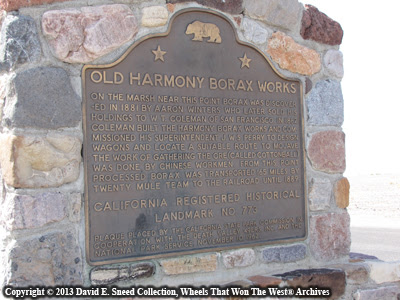Throughout America’s history, there are certainearly horse-drawn vehicles that have attained a legendary status… even amongthe general public. Examples include Wells Fargo’s Concord Coaches, thebig hitch wagons (along with the Clydesdales) of Anheuser-Busch, and the 20Mule Team Borax wagons. All are well entrenched symbols of renownedAmerican brands.
Among those of the largest physical proportions arethe 20 Mule Team Borax wagons. Not only did the entire long-line team andwagon train stretch over 100 feet in length but the wagons, themselves, aresubstantial in size. In other words, they’re big… correction, they’rehuge, massive, colossal, and any other oversized adjective you’d like toapply.
Built for the ultra-harsh demands of the rawCalifornia desert known as Death Valley, these wagons were used from 1883-1888to haul tens of thousands of pounds of borax over mile after mile of isolated,desolate and forbidding terrain. Modern travelers within this amazinglandscape typically enjoy the comforts of air conditioning and a pavedroad. Yet, within the deceptive beauty of the place, there is a reminderthat the environment still demands respect. During our trip, the windblew constantly. Sand pelted our car, faces and bodies. There wereplaces where small sand dunes were in the process of reclaiming thehighway. Mile after rugged mile, this region was equally deceptive as tothe wealth it held during the days of the forty-niners.
According to the book, “The Twenty Mule Team ofDeath Valley,” gold rush pioneers struggling to make it through this area asthey moved farther west, often referred to the region as ‘the dregs ofcreation.’ They were completely oblivious to the fortune in borax beneaththeir feet. The Death Valley find was reported by the ScientificAmerican in 1873 but, it would be another decade before extraction of thisparticular ‘white gold’ began in earnest. Since no rail lines were close,it was decided that a mule train of large wagons would need to be created todeliver the precious minerals 165 miles one way to the rails.

Up close, these wagons easily dwarf the human bodywhile standing as huge reminders of just how big the spirit of the west was(and is)… not to mention the heart of the animals responsible for pulling theseloads. The rear wheels of the lead wagons tower a full 7 feet in heightwith 1 inch thick steel tires stretching 8 inches in width. Spokes areover 2 feet in length and the circumference around the spoke bands is 4 ½feet! The brake blocks are equally impressive with measurements of 8inches wide and 43 inches in length. The box widths ranged between 44 and48 inches. Coupled with a 6 foot box height and a 16 foot box length,these vehicles weighed nearly 4 tons standing empty.
Enjoying early and large vehicle history as I do,these historic sets of wheels are a sight to behold. Like so many ofthese giant workhorses from the 19th century, they are but shells oftheir former selves. The sun, wind and weather attack themincessantly. Without further protection, they will one day succumb to thebeatings. I count it a privilege to have been able to be so close to sucha powerful symbol of our nation’s heritage. Today, borax is still a vitalmaterial with a wealth of uses. Areas like cosmetics, medicines,detergents, ceramics, plastics, fire retardants, flux, food additives, putty,insulation, water softeners, indelible ink, swimming pool maintenance,blacksmithing, moth-proofing wool, and even products designed to help stopradiator leaks all lean on the strength of borax. It’s a product withcountless uses and continues to play a significant role in lifeeverywhere. Ultimately, the story of the 20 Mule Team and Borax wagons isa testimony to the can-do spirit that built this land and a reminder of thevalue of freedom, the richness of our nation, and benefits of our freeenterprise system.






